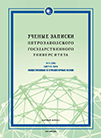КАДРОВОЕ ОБЕСПЕЧЕНИЕ СОВЕТСКИХ АРКТИЧЕСКИХ
ИССЛЕДОВАНИЙ В 1920-е ГОДЫ
HUMAN RESOURCING OF THE SOVIET ARCTIC RESEARCH IN 1920-s
Author(s): Aleksandr Alekseevich SaburovSubject(s): History, Geography, Regional studies
Published by: Петрозаводский государственный университет
Keywords: Arctic; research; USSR; staff; science; expeditions; polar stations; Northern Sea Route
Summary/Abstract: The author of the article analyzes human resourcing practice employed for the Soviet research of the Arctic islands and archipelagosin the 1920s. The analysis is carried out with the help of multiple archival materials and published sources. Characteristic featuresof human resourcing, training and motivation of the members of scientific expeditions and polar stations are studied in the paper.The present research studies activities of the Northern Scientific and Industrial Expedition (Severnaya nauchno-promyslovaya ekspeditsiya),Hydrographic Expedition of the Arctic Ocean (Gidrograficheskaya, ekspeditsiya Severnogo Ledovitogo okeana), FloatingMarine Research Institute (Plavuchii Morskoi Nauchnyi Institut). The author concludes that 1920s became a period of the humanresourcing system development. It was implemented for the research of the Soviet Arctic Area. Before the Russian revolution itpracticed irregularly. The beginning of the 1920s, in spite of the first attempts to create educational programs within several institutions,was characterized by the lack of specialized training, poor conditions of wintering, low salaries, poor-quality of food supplyand clothing for polar scientists. Scientific achievements of this period are explained mainly by the professionalism of experiencedresearchers – managers of scientific organizations (R. Samoilovich, V. Vize, N. Matusevich, I. Mesyatsev), who organized the workeffectively, united scientific groups, and attracted young researchers. In the second half of the 1920-s the human resourcing for Sovietscientific activities changed significantly because of the economic recovery and authorities’ attention to the Arctic. These changeswere expressed in the numeric increase of employees for scientific organizations and growth of researchers’ salaries. In addition,increased state involvement in to the process of science management provided basic regulation of the working environment, in particularthe system of payment and labor protection.
Journal: Ученые записки Петрозаводского государственного университета. Общественные и гуманитарные науки
- Issue Year: 2016
- Issue No: 5 (158)
- Page Range: 41-45
- Page Count: 5
- Language: Russian

